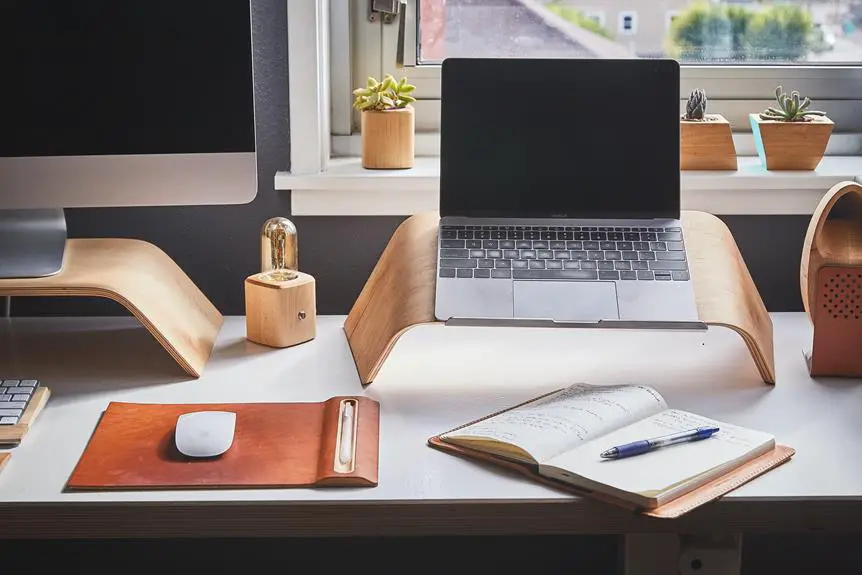So, you've finally decided to upgrade your home office setup with not one, but multiple monitors. The next logical step? Finding the perfect desk to accommodate your new tech-heavy workspace.
But with so many options out there, it can feel like diving into a bottomless pit of choices. Don't worry, though – we've got you covered. We're about to break down the key factors you need to consider when picking out a desk for your multi-monitor home office.
Trust us, it's not as daunting as it sounds.
Key Takeaways
- Consider an adjustable height desk for personalized comfort and ergonomics.
- Optimize corner space with a compact L-shaped desk.
- Prioritize spatial requirements and organization for an efficient work setup.
- Look for desks with high weight-bearing capacity for multiple monitors and equipment.
Desk Size and Configuration
When choosing a desk size and configuration for a multi-monitor home office, consider the spatial requirements and organization needed to accommodate your work setup efficiently.
Firstly, think about an adjustable height desk. This feature allows you to customize the desk to your preferred sitting or standing position, promoting better ergonomics and reducing strain on your body during long work hours. It's a game-changer for your comfort and productivity.
Next, let's talk about space-saving designs. In a multi-monitor setup, space is crucial. Look for desks with built-in shelves, drawers, or compartments to keep your work area tidy and organized. A compact L-shaped desk can optimize corner space, providing ample room for your monitors while leaving space for other work essentials.
Additionally, consider a desk with cable management features to keep all those monitor cables and power cords neat and out of the way.
Ergonomic Considerations
To ensure a comfortable and productive work environment, prioritize ergonomic considerations when selecting a desk for your multi-monitor home office. Proper monitor placement and screen ergonomics are essential for reducing strain on your body during long hours of work. Here are some key ergonomic considerations to keep in mind when setting up your multi-monitor home office desk:
| Ergonomic Consideration | Description | Tips |
|---|---|---|
| Monitor Placement | Position your monitors at eye level to avoid neck strain. | Use monitor arms or stands to adjust the height of your monitors. |
| Screen Ergonomics | Ensure that your screens are at arm's length and tilted slightly upwards. | Use an adjustable monitor stand or mount to achieve the optimal screen position. |
| Seating Ergonomics | Invest in an ergonomic chair with proper lumbar support and adjustable armrests. | Sit with your feet flat on the floor and maintain a 90-degree angle at your elbows and knees while typing. |
| Cable Management | Keep cables organized and out of the way to prevent tripping hazards and maintain a clean workspace. | Use cable clips, ties, or a cable management tray to keep cables tidy and secure. |
Cable Management Solutions
Now that you've ensured proper monitor placement and seating ergonomics, it's time to address the crucial aspect of cable management solutions in your multi-monitor home office setup. Keeping your cables organized and out of the way not only enhances the visual appeal of your workspace but also contributes to a more efficient and productive work environment.
To achieve an organized and clutter-free desk, consider investing in cable management and organization solutions. There are various space-saving options available, such as cable clips, sleeves, and trays that can help keep your cables neatly arranged and prevent them from tangling or becoming a tripping hazard.
Cable clips are handy for securing individual cables to the edge of your desk or along the backside, while cable sleeves can bundle multiple cords together, concealing them from view. Additionally, cable trays are an excellent way to route and store excess cables underneath your desk, freeing up valuable surface space and maintaining a clean and streamlined look.
Furthermore, incorporating cable management solutions not only enhances the aesthetics of your workspace but also simplifies maintenance and troubleshooting tasks. With organized cables, you can easily identify and access specific cords when needed, making it more convenient to add or remove devices from your setup.
Stability and Durability
For a stable and durable desk suitable for a multi-monitor home office, consider the weight-bearing capacity and construction materials to ensure it can support the weight of multiple monitors and other equipment.
When it comes to stability concerns, you want to make sure that your desk can handle the load without wobbling or bending.
Here are a few factors to keep in mind when assessing the stability and durability of a desk for your multi-monitor setup:
- Weight-Bearing Capacity: Look for desks with a high weight-bearing capacity, especially if you plan to mount multiple monitors and additional equipment. Desks with reinforced frames and sturdy legs are better equipped to handle the weight without compromising stability.
- Construction Materials: Opt for desks made from robust materials such as solid wood, steel, or metal. These materials offer superior durability and can withstand the weight of multiple monitors and other office equipment. Additionally, desks with cross-bracing or additional support structures provide added stability.
- Desk Material Choices: Consider the pros and cons of different desk materials. While solid wood offers a classic look and sturdy build, metal and steel desks provide exceptional durability and strength. Laminated desks can also offer a balance of affordability and stability, making them a practical choice for a multi-monitor home office setup.
Style and Aesthetics
Considering the stability and durability of your desk for a multi-monitor home office, the style and aesthetics should complement your workspace while enhancing productivity and comfort. When it comes to the aesthetic appeal of your desk, you want to choose a design that reflects your personal style and creates a pleasant work environment.
A desk with a sleek and modern design can bring a contemporary feel to your office space, while a more traditional desk can add a sense of warmth and professionalism. The right aesthetic can contribute to a positive work atmosphere, which is essential for maintaining focus and motivation.
Design versatility is also crucial when selecting a desk for your multi-monitor setup. Look for a desk that offers ample space and organization options, such as built-in shelves, drawers, or cable management systems. This will help you maintain a clean and clutter-free workspace, allowing you to stay organized and productive.
Ultimately, the style and aesthetics of your desk shouldn't only align with your personal preferences but also enhance the functionality of your home office. A well-designed desk can elevate the overall look of your workspace while providing the practical features you need to work efficiently.
Budget and Value
Looking for a desk that fits your budget while still providing great value? You're in the right place.
We'll explore cost-effective options, durability, and how to get the best value for your money when choosing a desk for your multi-monitor home office.
Cost-Effective Options
When outfitting your home office with a multi-monitor setup, it's essential to find cost-effective desk options that provide both value and functionality. Here are some budget-friendly choices:
- Space-Saving Solutions: Look for compact desks with built-in shelving or storage to optimize the use of space.
- DIY Options: Consider building your own desk using affordable materials like plywood and adjustable legs for a customized and cost-effective solution.
- Adjustable Height, Standing Desk: Invest in a desk that offers the flexibility of adjustable height, allowing you to switch between sitting and standing to promote better posture and reduce fatigue.
These options offer practical and budget-conscious solutions for setting up a multi-monitor home office without breaking the bank.
Durability and Price
If you're aiming for a desk that balances durability and price for your multi-monitor home office, it's important to seek out options that provide long-term value without straining your budget.
Look for desks made of sturdy materials like solid wood, metal, or high-quality laminate that can withstand the weight of multiple monitors and other office essentials.
While durability is essential, it's also crucial to find a desk that fits your budget. Consider options that offer a balance between affordability and quality.
Keep an eye out for desks with strong warranties or guarantees, as they can provide added assurance of long-lasting durability.
Value for Money
To get the best value for your money when choosing a desk for your multi-monitor home office, prioritize durability and functionality within your budget. Consider these key factors to ensure you're making a wise investment:
- Durability: Look for desks made from sturdy materials such as solid wood or metal to ensure longevity.
- Ergonomic Design: Opt for a desk with adjustable height and ample legroom to promote comfort and reduce strain during long work hours.
- Workspace Organization: Choose a desk with built-in cable management systems, drawers, and shelves to keep your multi-monitor setup organized and your workspace clutter-free.
User Reviews and Recommendations
You'll find valuable insights and practical advice from fellow users who've experience with multi-monitor desks. When reading user reviews, look out for assembly tips and setup processes. Many users share their experiences with the assembly process, offering tips and tricks to make it smoother. Some desks may come with complex instructions, while others are straightforward to put together. Pay attention to the details provided by reviewers to gauge whether the assembly process aligns with your preferences and skills.
Another important aspect highlighted in user reviews is the compatibility of the desk with mounts and stands. Users often discuss whether the desk accommodates different types of monitor mounts or stands, and how easy it's to set them up. This information is crucial, especially if you already have monitor mounts or stands that you plan to use with the new desk. Understanding the experiences of other users in this aspect can save you from potential compatibility issues and the hassle of finding workarounds.
Frequently Asked Questions
How Can I Ensure That My Multi-Monitor Desk Setup Is Compatible With My Specific Monitor Models and Sizes?
You want to make sure your multi-monitor setup fits perfectly on your desk. Check for monitor compatibility and mounting options. Look for an ergonomic desk with adjustable height to create a comfortable and efficient workspace.
Are There Any Specific Desk Features or Configurations That Are Better Suited for Certain Types of Work or Tasks, Such as Graphic Design or Video Editing?
For graphic design, an ergonomic setup with adjustable height and ample space is key. Video editing benefits from a desk with built-in cable management. Look for features that suit your work style and maximize productivity.
What Are Some Creative Ways to Hide or Disguise Cables and Wires in a Multi-Monitor Desk Setup?
To keep your multi-monitor desk setup organized, use cable management solutions like cable trays, sleeves, or clips. Consider integrating them into the desk design for a clean look. Explore various organization solutions to hide and disguise wires effectively.
How Can I Determine if a Desk Is Stable Enough to Support the Weight of Multiple Monitors and Other Equipment?
Before buying, ensure the desk is stable for your multi-monitor setup. Check weight capacity to support all equipment. Look for sturdy materials like steel or solid wood. Don't overlook this crucial aspect of desk shopping.
Are There Any Desk Styles or Aesthetics That Are Particularly Well-Suited for a Multi-Monitor Home Office Setup, Such as Minimalist or Industrial Designs?
When setting up a multi-monitor home office, consider minimalist desks for clean lines and ample workspace. Industrial-style desks offer a sturdy and modern aesthetic, while traditional designs may provide more storage options. Choose based on your needs and aesthetics.



